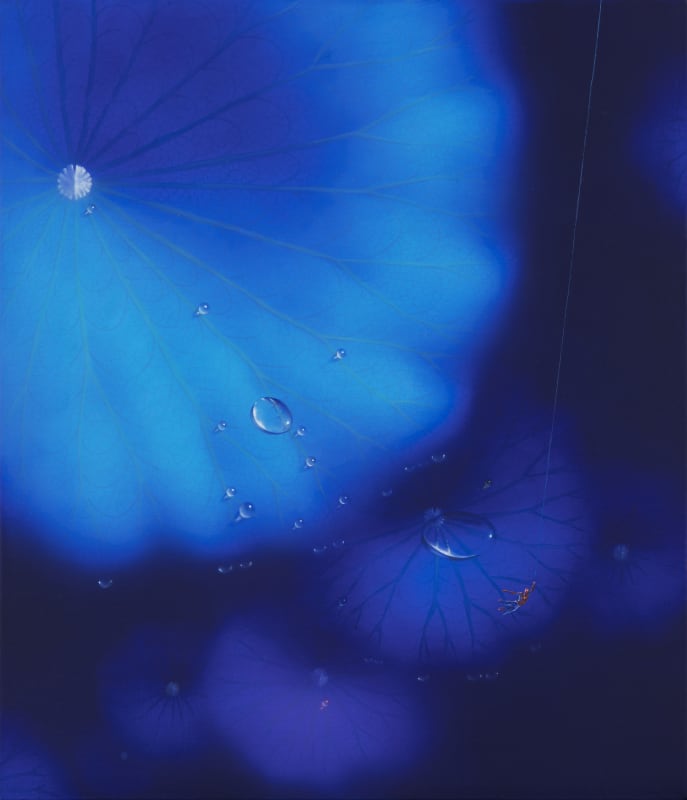As a satellite exhibition of Korean Art London 2023 – which opens for three weeks in July at Mall Galleries, London SW1, BLUE offers the opportunity to take a deeper dive into Sang Woon Nam’s extraordinary Blue Moon series of hyperrealist paintings.
Sang Woon Nam: The Blue Moon series
Sang Woon Nam invites us to see in the lotus leaf, risen to the water’s surface, a reflection of the moon. His dreamy palette glows with saturated ultramarine, his compositions are large and close-cropped. He isolates a single leaf to fill the frame, and it is transformed: alone, a fascinating luminous whole.
In nature, the lotus never blooms alone, they grow entangled with each other. Is the artist asking us to forget worldly affairs; to rid ourselves of contemporary distractions and make space for contemplation? Nam’s fifteen-year search for his signature ‘Blue Moon’ ultramarine – time spent devoted to developing an intense hue he hoped would express profound mystery and invite the eye to dive into the canvas – would suggest that he is.
Nam displays a similar dedication to the mastery of technique, as well as to an excruciating level of detail most easily seen in the delicate network of veins that crisscross the leaves' surfaces. As if to underline his deep commitment to technical artistry, and the importance of the artist’s hand, Nam equates this fine tracery to the veins that appear on his hands after many hours painting. A work can take up to three years to complete.
The lotus flower has, like the moon, long been a symbol of purity, creation and enlightenment, and its leaves are known for their smooth texture and water-repellent properties. In Buddhist teachings it has come to embody spiritual growth. For Nam, painting is a devotional act, his patiently acquired skills and his insights etched into the leaves on the canvas.
Glistening water droplets amplify the fertile lushness. But, poised as they are to run, there’s unavoidable tension. What’s more, look closely and you’ll discover that a corrupting element has been introduced to this Eden. There is a fly in the ointment. Nam often adds satirical elements, such as a car the size of a bug, to comment on man’s worldly desires. An allegory of the impending insect apocalypse, perhaps. Et in Arcadia Ego.
Sang Woon Nam’s Blue Moon series goes beyond mere representation, despite the photorealist style, to touch on more complex themes about the human experience. As the artist’s painstaking and repetitive actions are absorbed into the canvas, as his ethereal blue absorbs the mind, these serene paintings offer a profound visual experience that induces a state of tranquillity. The paradox being that they can also stir a deep sense of unease: the beauty and harmony of the lotus leaf – of life – is fleeting.
-------------
Starting with his first solo exhibition in 1998, Sang Woon Nam participated in a total of 20 solo exhibitions and 140 group exhibitions, and graduated from Hongik University with a doctorate in art.
The most recognisable feature of his “Blue Moon” paintings is the deep colours used. A blue, that is not deep enough to express its own depth. It is pitiful and lively, but it is so sorrowful that it adds mysteriousness to the canvas, almost as to invite the audience to dive in a deep ocean.
Sang Woon Nam has experimented with paints to find the perfect blue that would translate this desire to express an intense feeling for more than fifteen years, through an intense procedure of repeatedly mixing, drying, and repainting the canvas. This strenuous procedure has led him to finally find the perfect shade, recognised as his signature colour.
The lotus leaf, which skilfully overlaps reality and virtual image, represents the utopia that everyone dreams of. The artist instilled a humour as expressed the humans’ worldly desires by adding a car that is only about a centimetre big on the lotus leaf. At the same time, he adds veins to the lotus leaves to express his journey through the painting, resembling his hands that get veiny after his hard work and extended painting hours.


